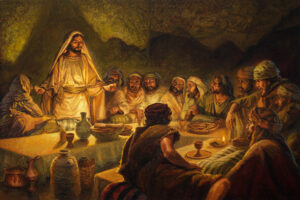
The Communion of Saints
In all the hullabaloo of trick-or-treating and visiting family members, All Saints’ Day (November 1) passed me by this year with hardly a whisper. It’s a sacred holy day for our family: the day of my mother’s birth, our engagement, and both of our kids’ baptisms. Nevertheless, the undertow of ministry and motherhood grabbed me this year. I totally missed it.
Thankfully, the liturgical calendar is forgiving. The following day, the Church recognizes All Souls’ Day (the Feast of the Commemoration of the Faithful Departed)—a day centered on remembrance of those who have died in Christ. All the reflection I forgot to do on November 1 swept over me on November 2, as I sat at my desk texting back and forth with a priest friend of mine. We prayed, quietly in our own offices, over the names of the faithful departed—friends’ miscarried and stillborn babies, beloved friends, parishioners, and family members. We wept. We shared sources of consolation, like the image from a sermon he once preached of us—you and me—“being led by a slain Lamb as our Shepherd. One day, those ahead of us will pass the torch and we’ll step to the front of that procession.”
Just then, the sound of singing filled the Parish Hall. I ran down the hallway to find many of the senior adults in our parish singing Amazing Grace as Herbert Washington led them on the piano. My faithful brothers and sisters, a bit further along on the road than I, carrying the torch: “When we’ve been there ten thousand years, bright-shining as the sun, we’ve no less days to sing God’s praise than when we’ve first begun.”
I’ve heard it said before that the greatest task of pastoral ministry is teaching people to die. It is, after all, the certain outcome of each and every human life. But All Souls’ Day is a liturgically-appointed time to remember that those who die in Christ do not die forever. This is not a trite consolation to soften the inevitability of death—it is Christian doctrine. If you pray the Daily Office, you declare belief in this doctrine each day when you recite the Apostles’ Creed: “I believe in the Holy Spirit, the holy catholic Church, the communion of saints, the forgiveness of sins, the resurrection of the body, and the life everlasting” (emphasis mine).
 From the earliest days of the Church’s history, Christians have professed faith in what Fr. Thomas McKenzie described as a miles-long communion table. When we take the Eucharist at Christ Church on Sunday mornings, we dine at a table that stretches on for miles. We dine alongside one another, yes, but we also dine alongside the faithful departed who have fallen asleep. This is a profound mystery, about which St. Gregory the Great writes, “Can any of the faithful doubt that at the hour of the Eucharist…the choir of angels are present, the heights joined to the depths, earth linked with heaven, the visible united with the invisible” (Dialogue 4.60). At the Eucharistic table, we brush elbows with the living and the dead, taking spiritual food and drink with all of Christ’s beloved.
From the earliest days of the Church’s history, Christians have professed faith in what Fr. Thomas McKenzie described as a miles-long communion table. When we take the Eucharist at Christ Church on Sunday mornings, we dine at a table that stretches on for miles. We dine alongside one another, yes, but we also dine alongside the faithful departed who have fallen asleep. This is a profound mystery, about which St. Gregory the Great writes, “Can any of the faithful doubt that at the hour of the Eucharist…the choir of angels are present, the heights joined to the depths, earth linked with heaven, the visible united with the invisible” (Dialogue 4.60). At the Eucharistic table, we brush elbows with the living and the dead, taking spiritual food and drink with all of Christ’s beloved.
And on the last day, when the doors of Christ Church’s Columbarium swing open and death is swallowed up forever, we will dine then, too—in the company of all the saints. St. Augustine. St. Gregory the Great. My priest friend and me. But most importantly, we will dine with Jesus, whose power alone can bring about “the resurrection of the dead, and the life of the world to come.”
Grace and Peace,
Dcn. Bree

